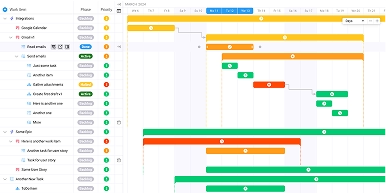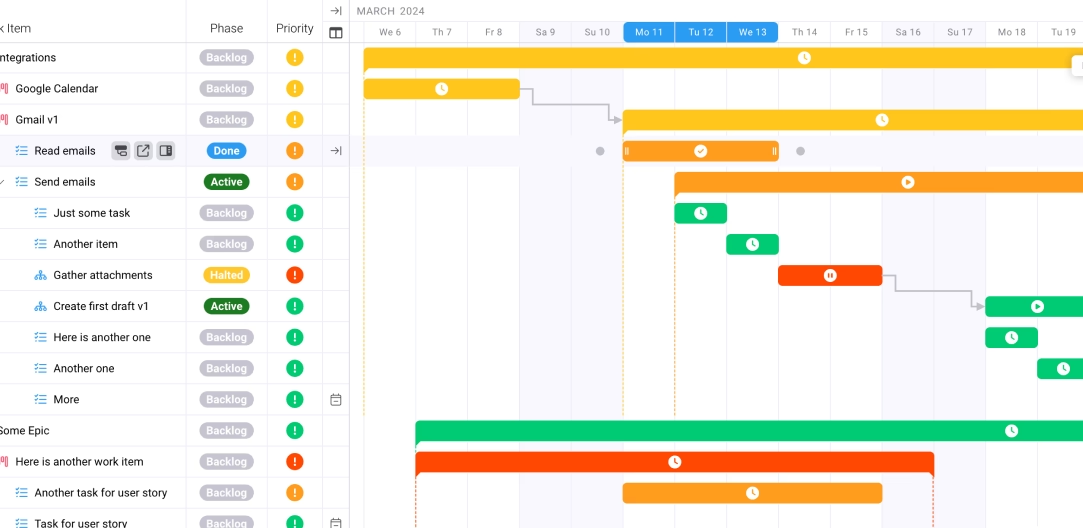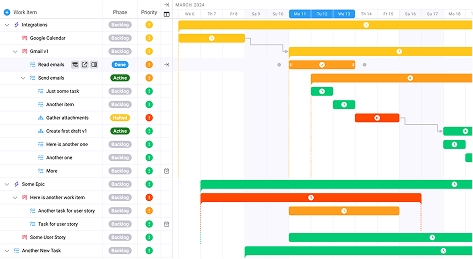
Top Tips For Managing Billable Projects
Key takeaways:
- Utilization optimization: Achieve 85-90% billable utilization rates through strategic resource planning and robust time tracking systems
- Scope control mastery: Implement formal change management processes to prevent scope creep, which affects over 52% of projects
- Technology leverage: Modern project management software can increase productivity by up to 50% and save 20% on project costs
- Proactive communication: Establish clear expectations and regular stakeholder touchpoints to maintain project profitability and client satisfaction
The harsh reality of managing billable projects is that professional services organizations achieve an average billable utilization rate of 69% in 2023, falling significantly short of the optimal performance threshold. This startling statistic reveals a massive opportunity cost that’s quietly draining profitability from agencies, consultancies, and professional services firms worldwide. Managing billable projects effectively isn’t just about getting work done—it’s about maximizing every revenue-generating hour while maintaining exceptional client satisfaction and team productivity.
The Current Challenge – What’s Broken in Billable Project Management
The professional services industry faces a profitability crisis that most leaders don’t fully comprehend. Billable utilization has fallen to just 68.9% in 2024, below the 75% optimal threshold, creating a devastating gap between potential and actual revenue generation. This decline isn’t just a statistical blip—it represents millions in lost revenue across the industry.
The root causes run deeper than simple time management issues. 52% of all projects face scope creep in one way or another according to PMI data, fundamentally undermining the financial viability of billable work. When projects expand beyond their original parameters without corresponding budget adjustments, firms essentially provide free services that erode margins and strain resources.
Modern professional services teams struggle with fragmented workflows, inadequate visibility into resource allocation, and reactive approaches to project changes. The consequences extend beyond immediate financial losses—teams become overwhelmed, client relationships suffer, and organizational growth stagnates.
Yet the opportunity for improvement is substantial. Organizations that use project management practices have a 92% success rate in meeting project objectives, demonstrating that systematic approaches to billable project management can transform business outcomes.
The Strategic Framework – A Comprehensive Approach to Billable Project Excellence
Successful managing billable projects requires a systematic framework that addresses four critical dimensions: strategic planning, operational execution, performance monitoring, and continuous optimization. This framework shifts teams from reactive fire-fighting to proactive value creation.
Strategic Planning Foundation
The framework begins with rigorous upfront planning that establishes clear boundaries, deliverables, and success metrics. This involves comprehensive scope definition, resource requirement analysis, and risk assessment protocols that prevent common pitfalls before they emerge.
Operational Excellence Layer
Day-to-day execution focuses on maximizing billable hour efficiency through streamlined workflows, automated administrative tasks, and real-time project visibility. Teams implement robust time tracking systems, standardized communication protocols, and change management processes that maintain project integrity.
Performance Monitoring System
Continuous measurement enables data-driven decision making through utilization rate tracking, project profitability analysis, and client satisfaction monitoring. This creates feedback loops that inform future project planning and resource allocation decisions.
Optimization Engine
Regular review cycles identify improvement opportunities, capture lessons learned, and refine processes for enhanced performance. This ensures the framework evolves with changing business needs and market conditions.
Implementation Tactics – Five Proven Strategies for Billable Project Success
1. Optimize Billable Utilization Through Strategic Resource Planning
Service companies should aim to achieve a utilization rate of between 85-90% to maximize profitability, but reaching this target requires sophisticated resource planning capabilities. The key lies in balancing workload distribution while maintaining quality standards and preventing team burnout.
Effective resource planning starts with accurate capacity forecasting that considers individual skills, availability, and project requirements. Teams should implement resource allocation matrices that match the right people to the right projects based on expertise and availability. This strategic approach prevents both underutilization and overcommitment scenarios that damage profitability.
Time tracking becomes critical for optimization. Billable hours are the bread and butter of professional services firms, making accurate capture essential for both billing accuracy and performance improvement. Modern time tracking solutions provide granular visibility into how hours are spent, enabling teams to identify and eliminate non-value-added activities.
Consider implementing dedicated time tracking protocols that categorize all activities as billable or non-billable. This distinction helps teams understand where productivity gains are possible and ensures accurate client billing. Regular analysis of time allocation patterns reveals opportunities for process improvements and workflow optimization.
2. Leverage Technology to Maximize Efficiency and Productivity
The technology advantage in managing billable projects cannot be overstated. Upgrading to modern project management software can increase productivity by up to 50% and save up to 20% on project costs, making the investment case compelling for any professional services organization.
Project management software helps employees save 498 hours per year on average, freeing teams to focus on high-value client work rather than administrative overhead. This time savings directly translates to increased billable utilization and improved project profitability.
When evaluating project management solutions, prioritize platforms that integrate time tracking, project management, resource planning, and billing capabilities. Choosing the right project management software is crucial for managing billable hours effectively, as fragmented systems create inefficiencies and data silos that undermine optimization efforts.
Ravetree stands out as the best project management solution for managing billable projects, offering comprehensive features that address every aspect of professional services project management. From automated time tracking to sophisticated resource planning and seamless billing integration, Ravetree provides the technological foundation for billable project excellence.
Advanced features should include automated workflow triggers, real-time project dashboards, and customizable reporting capabilities. These tools enable proactive project management rather than reactive responses to problems. Integration with financial systems ensures accurate invoicing and reduces administrative burden on project teams.

3. Implement Rigorous Scope Management and Change Control
Scope creep occurs when scope or requirements management doesn’t occur properly, making formal change control processes essential for maintaining project profitability. Effective scope management protects billable hour budgets while maintaining positive client relationships.
Establish clear project boundaries through detailed statements of work that specify deliverables, timelines, and acceptance criteria. These documents serve as contracts that protect both parties and provide reference points when scope questions arise. Include explicit language about change request procedures and associated costs.
Effective project deliverable management ensures billable work stays on track and within scope, requiring systematic tracking of all project outputs against original specifications. This proactive approach prevents scope drift and maintains focus on revenue-generating activities.
Implement formal change request processes that require written documentation, impact analysis, and client approval before proceeding with scope modifications. This systematic approach ensures that scope changes generate appropriate revenue while maintaining project timelines and resource allocation.
Create change impact assessment templates that evaluate proposed modifications against time, budget, and resource implications. This analytical approach helps clients understand the true cost of changes and supports informed decision-making about project modifications.
4. Establish Proactive Communication and Stakeholder Management
Communication breakdowns are among the leading causes of project failures and billing disputes. Establishing structured communication protocols prevents misunderstandings while building trust and confidence with clients throughout the project lifecycle.
Develop communication plans that specify touchpoint frequency, reporting formats, and escalation procedures. Regular status updates keep stakeholders informed while providing opportunities to address concerns before they become major issues. This proactive approach reduces project risk and maintains positive client relationships.
Implement client portal solutions that provide real-time project visibility without creating administrative burden for project teams. Clients appreciate transparency and self-service access to project information, reducing the volume of status inquiries and enabling teams to focus on billable work.
Create standardized reporting templates that highlight project progress, upcoming milestones, and any issues requiring attention. Consistent reporting builds confidence while providing documentation for billing and project closure activities.
5. Monitor Performance and Optimize Continuously
Successful managing billable projects requires ongoing performance monitoring and optimization. Without systematic measurement, teams cannot identify improvement opportunities or validate the effectiveness of process changes.
Implementing proven project management best practices is essential for billable project success, but these practices must be continuously refined based on performance data and changing business requirements.
Establish key performance indicators that track utilization rates, project profitability, client satisfaction, and team productivity. Regular analysis of these metrics reveals trends and patterns that inform strategic decisions about resource allocation and process improvements.
Conduct post-project reviews that capture lessons learned and identify opportunities for future optimization. These retrospective analyses provide valuable insights for improving estimation accuracy, resource planning, and client communication approaches.
Implement feedback loops that enable continuous process refinement based on project outcomes and team experiences. This learning organization approach ensures that billable project management capabilities improve over time rather than remaining static.
Measuring Success – KPIs and Metrics That Drive Billable Project Performance
Effective measurement systems provide the foundation for managing billable projects successfully. Without accurate metrics, teams cannot assess performance, identify problems, or validate improvement initiatives. There are four plateaus that allow organizations to measure the return on investment of project management, ranging from basic comprehension to sophisticated ROI calculations.
Utilization Rate Tracking
Monitor billable utilization rates across individuals, teams, and the entire organization. Target rates should align with role requirements, with delivery team members typically achieving 85-90% utilization while managers and business development professionals maintain lower targets that reflect their non-billable responsibilities.
Project Profitability Analysis
Track project margins by comparing actual costs against budgeted amounts and billing rates. This analysis reveals which project types and clients generate the highest returns, informing future business development and pricing decisions.
Client Satisfaction Metrics
Regular client feedback surveys provide insights into satisfaction levels and identify opportunities for service improvements. High satisfaction scores typically correlate with repeat business and referral opportunities that drive long-term growth.
Time Tracking Accuracy
Monitor the timeliness and completeness of time entry to ensure billing accuracy and productivity measurement. Late or incomplete time entries create billing delays and reduce the reliability of performance metrics.
Change Request Frequency
Track the number and scope of change requests across projects to identify patterns and opportunities for improved scope definition. Frequent changes may indicate inadequate upfront planning or unclear client communications.
Future Considerations – Emerging Trends and Strategic Positioning
The landscape of billable project management continues evolving as technology advances and client expectations shift. Professional services organizations must anticipate these changes and position themselves for continued success in an increasingly competitive market.
Artificial Intelligence Integration
AI-powered project management tools are beginning to provide predictive analytics for resource planning, automated administrative tasks, and intelligent project insights. Early adopters of these technologies will gain competitive advantages through enhanced efficiency and improved decision-making capabilities.
Remote and Hybrid Work Optimization
The shift toward distributed teams requires new approaches to collaboration, communication, and performance monitoring. Organizations that master remote billable project management will access broader talent pools while maintaining high performance standards.
Value-Based Pricing Evolution
Market pressures are driving evolution from hourly billing toward value-based pricing models that align service provider incentives with client outcomes. This transition requires sophisticated project management capabilities and deep understanding of client value creation.
Sustainability and Social Responsibility
Growing emphasis on environmental and social responsibility affects project management approaches, requiring consideration of sustainability impacts and stakeholder welfare in project planning and execution decisions.
Client Experience Innovation
Rising client expectations for transparency, responsiveness, and self-service capabilities are driving innovation in client communication and project visibility tools. Organizations that excel in client experience will differentiate themselves and command premium pricing.
Managing billable projects effectively requires systematic approaches that optimize utilization, control scope, leverage technology, and maintain strong client relationships. The strategies outlined in this guide provide a comprehensive framework for achieving excellence in billable project management while building sustainable competitive advantages.
Success in managing billable projects ultimately depends on commitment to continuous improvement, investment in appropriate technology solutions, and focus on delivering exceptional value to clients. Organizations that excel in these areas will thrive regardless of market conditions or competitive pressures.
Frequently Asked Questions
What is the optimal billable utilization rate for professional services?
Most professional services firms should target billable utilization rates between 85-90% for delivery team members, while allowing for lower rates among managers who spend significant time on business development and administrative activities.
How can technology improve billable project management?
Modern project management software can increase productivity by up to 50% through automated administrative tasks, real-time project visibility, integrated time tracking, and streamlined communication tools that reduce non-billable overhead.
What causes scope creep in billable projects?
Scope creep typically results from unclear initial requirements, inadequate change control processes, poor stakeholder communication, and informal approval of small changes that accumulate over time to create significant budget and timeline impacts.
How should professional services firms handle change requests?
Implement formal change request processes that require written documentation, impact analysis including time and cost implications, and explicit client approval before proceeding with any scope modifications.
What metrics are most important for billable project success?
Key metrics include billable utilization rates, project profitability margins, client satisfaction scores, time tracking accuracy, and change request frequency to provide comprehensive visibility into project performance.
How can teams prevent budget overruns in billable projects?
Prevent budget overruns through accurate upfront estimation, regular budget monitoring, formal scope control processes, proactive risk management, and clear communication about project constraints and limitations.
What role does client communication play in billable project success?
Proactive client communication prevents misunderstandings, builds trust, reduces change requests, and maintains positive relationships that support repeat business and referral opportunities.
How often should teams review billable project performance?
Conduct weekly reviews of utilization rates and project progress, monthly analysis of profitability trends, and quarterly strategic assessments of overall performance and improvement opportunities.









